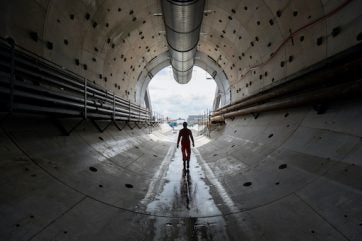
TBM Cecilia arrived at the northern portal to finish its journey building the 16km Chiltern tunnel in Buckinghamshire. The TBM was launched in June 2021.
Sister TBM, Florence, broke through on the twin-bore tunnel on February 27.
The two 2,000 tonne Herrenknecht machines have built the tunnel at depths of up to 80m and between them excavated 3 million m3 of chalk. They made an average advance of 16m per day and each installed 56,000 concrete tunnel segments.
HS2 Ltd’s head of civil works for this section of the route, Mark Clapp, said the final breakthrough was a remarkable achievement for all concerned.
“Cecilia’s arrival completes excavation of HS2’s 10-mile twin-bore tunnel, but it’s only the end of the first chapter in the story of building Britain’s high-speed railway under the Chiltern Hills,” he said.
“Several years of intensive, world class engineering lie ahead of us to complete the tunnels’ four ventilation shafts plus headhouses; install the mechanical and electrical plant and machinery, slab track and overhead electrical wires before trains begin passing through at 200mph.”
Both machines launched from the tunnel’s south portal, near the M25 motorway, were operated by HS2’s main works contractor, Align – a joint venture comprising Bouygues Travaux Publics, Sir Robert McAlpine, and VolkerFitzpatrick.
Align’s underground construction director, Didier Jacques, said 16km was a long drive for a TBM; a typical average was around 4.8km.
“The complexity and technically challenges of completing such a long drive for both our TBMs has been significant, however, I am delighted that as a team, we have risen to the challenge,” he said.
“Both TBMs were designed in partnership with Herrenknecht and incorporate innovations and technologies that have been introduced on TBMs in the UK for the first time, to enhance performance and safety. This includes ‘semi-continuous boring’, allowing our TBMs to build the rings that line the tunnels without pausing.”
Each TBM was operated by a crew of around 17, working in shifts to keep the machines running when required 24/7. They were supported by over 100 people on the surface, managing the logistics and maintaining the progress of the tunnelling operation.
In total over 450 people have worked on the tunnels over the past three years, including a dedicated production team that made 112,000 fibre-reinforced concrete tunnel wall segments on site at a purpose-built temporary factory, and a team processing the spoil from the tunnels.
Four similar TBMs are being used for the London approach tunnels, while another two will work on Birmingham’s Bromford tunnel. The two TBMs supplied for the Euston Tunnel will be launched this year and stored under Old Oak Common Station until the government gives approval for the line to be extended to Euston Station in central London.







